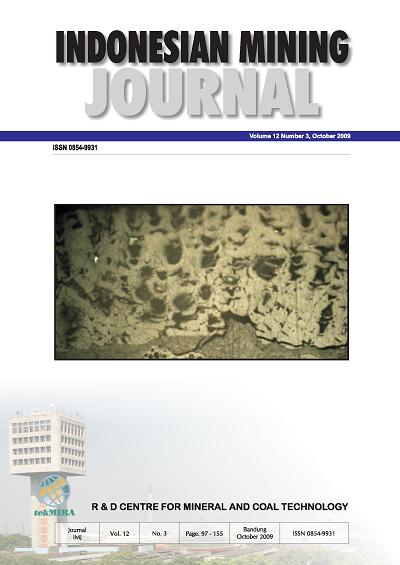ALTERATION OF MONTMORILLONITE CLAY TO SOLID ACID CATALYST BY HEATING AND ACID SOAKING
DOI:
https://doi.org/10.30556/imj.Vol12.No3.2009.552Keywords:
solid catalyst, montmorilonite clay, activation, acid number, conversionAbstract
Commercial biodiesel production nowadays still uses sodium hydroxide solution as homogenous catalyst. This catalyst has some weaknesses, which cannot be reused and difficult on its separation from the product (methyl esther). Therefore, alternative catalyst is necessary to be sought to solve the problem and solid catalyst from clay has a possibility to be applied. Montmorilonite clay is widespread mineral in Indonesia and its layer structure is potential to be used as solid catalyst. The alteration processes consist of upgrading montmorillonite content followed by activation and esterification to review its performance. Previous activa- tion was carried out using aqueous sulphuric acid of 0.05; 0.5; 5 and 10 M and settled in each solution for two weeks. To obtain shorten activation time, modified method has been done with similar acid strength range but using preheating 60°C for 6 hours and settled within a week. Clay’s performance was observed by esterification reaction using Palm Fatty Acid Distillate (PFAD) of fried oil production waste as raw material. Its initial and final acid number were then reviewed. The conversion of PFAD to esther was measured from deviation of initial of final acid number. Previous method’s result of 2 weeks settlement showed maximum conversion of 91.6% at 5M acid strength of activation, while modified method reached maximum conversion only 67.63% at similar acid strength of activation. Both results were not yet resemble the 5M sulphuric acid solution as homogenous catalyst which is able to convert PFAD to esther as much as 98.73%. However, the method of 2 weeks settlement could be developed further to gain the optimum conversion.
References
Adamis, Z. and Williams, R.B., 2005. Bentonite, ka- olin and selected clay minerals. International Programme on Chemical Safety. World Health Organization,Jenewa.
Amalia, D., Aziz, M., Sidjabat, O., Suryo,S. and Rodliyah, S., 2008. Benefisiasi lempung untuk bahan katalis sintesis biodiesel. Laporan Teknik Penelitian Pengolahan Mineral Puslitbang Teknologi Mineral dan Batubara (tekMIRA).
Bergaya, F. T. and Lagaly, G., 2006. Handsbook of clay science. Elsevier Ltd, UK.
Destiana, M., Zandy, A. N. dan Puspasari,S., 2009. Intensifikasi proses produksi biodiesel. Laporan Lomba Karya Ilmiah Mahasiswa ITB Bidang Energi Penghargaan PT. Rekayasa Industri. Institut Teknologi Bandung & PT. Rekayasa Industri.
Dominguez, E., Mas, G., and Cravero, F., 2003. Clays in industry. A clay odissey. Elsevier Science B.V., Netherlands.
Fabian, H. and Griyandi, 2005. Kajian eksploratif bahan katalis keramik untuk sintesis biodiesel. Laporan Thesis, Institut Teknologi Bandung.
Khan, A., 2002. Research into biodiesel catalyst screening & development. Brisbane, Australia.
Perry, R. and Green D., 1999. Perry’s chemical engi- neers’ handbook. McGraw-Hill Companies, Inc.
Wijaya, K., 2009. Asam padat berbasis montmorillonit sebagai katalis dalam proses pembuatan biodiesel dari minyak jelantah. Material canggih, rekayasa material berbasis sumber daya alam silica-alumina. Yogyakarta. ISBN 979-1707-70-7.
Yessi, A., 2007. Pengembangan montmorilonit sebagai katalis sintesis biodiesel melalui esterifikasi palm fatty acid distillate. Departemen Teknik Kimia Fakultas Teknologi Industri ITB. Bandung.
Downloads
Issue
Section
License
Indonesian Mining Journal provides immediate open access to its content on the principle that making research freely available to the public to supports a greater global exchange of knowledge.

This work is licensed under a Creative Commons Attribution-NonCommercial 4.0 International License.













